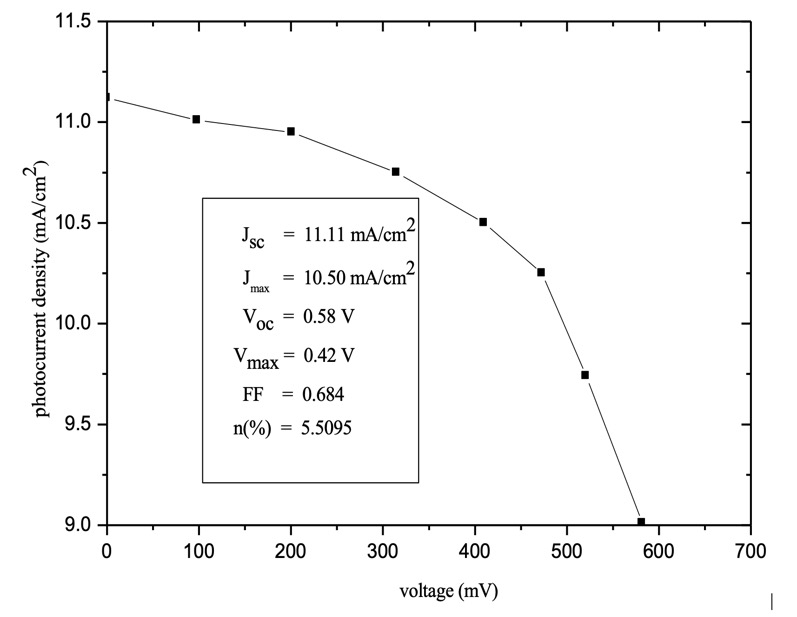Electrical energy efficiency of dye sensitized solar cells by polymer electrolyte
DOI:
https://doi.org/10.55674/cs.v16i2.254800Keywords:
Dye sensitized solar cells, Polymer electrolyte, efficiencyAbstract
This research aims to prepare by mixtures method with dope carbon black as a working electrode and the apply it to the dye sensitized solar cells (DSSCs). The thin film of titanium dioxide nanocrystalline semi - conductor with dope carbon black, the cells were coated on to transparent conducting oxide glass sheet by means of the doctor blade technique as a working electrode. But the polymer electrolyte were prepare by adding potassium iodide and iodine salts with a ratio of KI:I2 was 10:1, into a polymer electrolyte composed of poly-ethylene glycol, ethylene carbonate and poly(styrene–co–acrylonitrile). The polymer electrolyte mixtures became homogeneous and stirring at a temperature of 80 °C. Found that efficiency for the DSSCs by polymer electrolyte based on yielded an overall light to electrical energy conversion efficiency ( ) of the DSSCs was 5.5095%, An open-circuit voltage of 0.58 V, voltage at the point of maximum power output of 0.42 V, short-circuit current density of 11.11 mA.cm–2, current density at the point of maximum power output of 10.50 mA.cm–2 fill factor of 0.684 under an irradiation of 80 mW.cm–2. And the long-term stability test of the DSSCs with a polymer electrolyte is evidently superior to the DSSCs with liquid electrolyte based on the observation period lasting for 90 days.
GRAPHICAL ABSTRACT

HIGHLIGHTS
-
prepare by mixtures method with dope carbon black as a working electrode
- The efficiency for the DSSCs by polymer electrolyte based on yielded an overall light to electrical energy conversion
References
B. Li, L. Wang, B. Kang, P. Wang, Y. Qiu, Review of recent progress in solid-state dye-sensitized solar cells, Sol. Energy Materials Solar. 90 (2006) 549 – 573. 10.1016/j.solmat.2005.04.039.
B. O’Regan, M. Grätzel, A Low-Cost, High-Efficiency solar cell based on dye-sensitized colloidal TiO2 Films, Nature. 353 (1991) 737 – 740. 10.1038/353737a0.
Y.J. Kim, J.H. Kim, M.S. Kang, M.J. Lee, Y. Won, J.C. Lee, Y.S. Kang, Supramolecular electrolytes for use in highly efficient dye-sensitized solar cells. Adv. Mater. 16 (2004) 5250. 10.1002/adma.200306664.
A.F. Nogueira, C. Longo, M.A.D. Paoli, Polymers in dye sensitized solar cells:overview and perspectives, Coordin Chem. Rev. 248(13 – 14) (2004) 1455 – 1468. 10.1016/j.ccr.2004.05.018.
P. Wang, S.M. Zakeeruddin, P. Comte, I. Exnar, M. Grätzel, Gelation of ionic liquid- based electrolytes with silica nanoparticles for quasi solid- state dye-sensitized solar cells, J. Am. Chem. Soc. 25 (2003) 1166. 10.1021/ja029294+.
J.B. Xia, F.Y. Li, C.H. Huang, J. Zhai, L. Jiang, Improved stability quasi-solid-state dye sensitized solar cell based on polyether framework gel electrolyte, Sol. Energ. Mat. Sol. C. 90(7 – 8) (2006) 944 – 952. 10.1016/j.jpowsour.2008.09.034.
Y.J. Ren, Z.C. Zhang, S.B. Fang, M.Z. Yang, S.M. Cai, Application of PEO based gel network polymer electrolytes in dye sensitied photoelectrochemical cells, Sol. Energ. Mat. Sol. C. 71 (2002) 253 – 259. 10.1016/S0927-0248(01)00084-8.
X. Zhang, H. Yang, H.M. Xiong, F.Y. Li, Y.Y. Xia, A quasi solid state dye-sensitized Solar cell based on the stable polymer-grafted nanoparticle composite electrolyte. J. Power Sources. 160 (2006) 1451 – 1455. 10.1016/J.JPOWSOUR.2006.03.008.
Z. Lan, J.H.Wu, D.B. Wang, S.C. Hao, J.M. Lin, Y.F. Huang, Quasi-solid- state dye- sensitized solar cells based on a sol–gel organic– inorganic composite electrolyte containing an organic iodide salt, Sol. Energy. 81(1) (2007) 117 – 122. 10.1016/j.solener.2006.05.003.
J.H. Wu, Z. Lan, J.M. Lin, M.L. Huang, S.-C Hao, T. Sato, S. yin, A Novel thermosetting gel electrolyte for stable quasi solid-state dye-sensitized solar cell. Adv.Mater. 19(22) (2007) 4006 – 4011. 10.1002/adma.200602886.
F.J. Li, F.Y. Cheng, J.F. Shi, F.S. Cai, M. Liang, J. Chen, Novel quasi-solid electrolyte for dye-sensitized solar cells, J. Power Source. 165 (2007) 911 – 915. 10.1016/j.jpowsour.2007.01.005.
S. Ito, S.M. Zakeeruddin, R. Humphry-Baker, P. Liska, R. Charvet, P. Comte, M.K. Nazeeruddin, P. Pechy, M. Takata, H. Miura, S. Uchida, M. Grätzel, High efficiency organic dye sensitized solar cells controlled by nanocrystalline TiO2 electrode thickness. Adv. Mater. 18 (2006) 1202. 10.1002/adma.200502540.
T. Horiuchi, H. Miura, K. Sumioka, S. Uchida, High efficiency of dye-sensitized solar cells based on metal free indoline dyes, J. Am. Chem. Soc. 126 (2004) 12218. 10.1021/ja0488277.
X. Shen, W. Xu, J. Xu, G. Liang. H. Yang, M. Yao, Quasi-solid-state dye-sensitized solar cells based on gel electrolytes containing different alkali metal iodide salt. Solid State Ionics. 179(35 – 36) (2008) 2027 – 2030. 10.1016/j.ssi.2008.06.027.
T. Stergiopoulos, M.C. Bernard, A.H.L. Goff, Fararas, P. Resonance, Review resonance micro-Raman spectrophoto electrochemistry on nanocrystalline TiO2 thin film electrodes sensitized by Ru(II) complexes. Coord Chem Rev. 248(13 – 14) (2004) 1407 – 1420. 10.1016/j.ccr.2004.03.023.
M. Grätzel, Perspectives for dye sensitized nanocrystalline solar cells. Prog Photovolt Res. 8 (2000) 171. 10.1002/(SICI)1099-159X(200001/02)8:1<171::AID-PIP300>3.0.CO;2-U

Downloads
Published
How to Cite
Issue
Section
Categories
License
Copyright (c) 2024 Creative Science

This work is licensed under a Creative Commons Attribution-NonCommercial-NoDerivatives 4.0 International License.








